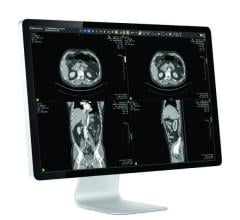Perhaps the biggest trend in health information technology today is the movement away from traditional picture archiving and communications systems (PACS) and cardiovascular information systems (CVIS) to enterprise imaging and data management systems. This migration is important, because it will fundamentally change how clinicians have been accessing images and patient information for the past 20 years.
The basic idea of enterprise imaging is to take all data (which includes images, waveforms, reports and other patient data) and amalgamate it into one place, instead of the current system of data residing in numerous, disconnected departmental data silos. With the introduction of vendor neutral archives (VNAs) and cloud-based (or Web-based) digital archives, data from all departments can be put into one pot and accessed using a universal viewer. This enables the data to be managed by the healthcare system’s information technology (IT) staff, rather than individual departments or radiology. Content management software is used to sort the data so it can be pulled out of the system and sent to where it needs to go. Using this model, a patient’s electronic medical record (EMR) can include embedded links to reports and images from all specialty departments in one location by interfacing with the central archive. VNAs also help overcome many of the issues with interoperability between various departments and software vendors’ systems that plague most hospitals.
The buzz term at the 2014 Radiological Society of North America (RSNA) meeting in December was “deconstructing” PACS and CVIS. In this concept, the VNA provides access to the data so the components of PACS and CVIS can be pulled apart. In this manner, a department can pick the best viewers, DICOM worklists and reporting software from various vendors to build what they feel is a best of breed system. This new concept has led some traditional PACS vendors to no longer use the term “PACS” and instead refer to their systems only as “enterprise imaging systems.”
The Need for Enterprise Imaging
Radiology has traditionally been the gatekeeper of imaging, with images residing in a siloed radiology PACS. However, as healthcare becomes more digitized and nearly all specialties now generate images and reports that need to be archived electronically and made accessible via EMRs, the traditional radiology PACS is becoming just one cog in a much larger healthcare machine. Specialties such as cardiology, orthopedics, oncology, women’s health and pathology now generate vast numbers of imaging files on their own, giving rise to specialty PACS. However, the need to connect these multiple, disparate systems into one electronic patient record has proven a major difficulty for all healthcare systems that have attempted it. Despite the advent of IHE (integrating the healthcare enterprise) profiles to make healthcare software for various vendors more compatible, there are just too many variables to ensure the smooth flow of data from point A to point B across an enterprise. VNAs help enable connectivity in a healthcare enterprise, similar to the Internet enabling connectivity between millions of people globally who are using different operating platforms.
The VNA platform also can serve as a disaster recovery system or the backbone of a health information exchange (HIE).
The Role of Healthcare Reform
Healthcare reforms under the Affordable Care Act (ACA) demands all healthcare IT systems interoperate to improve efficiency. The law also calls for leveraging IT to transform healthcare from a volume-based to a quality-based reimbursement system. With the expanded use of EMRs demanded as a component of the ACA, the federal government has established Meaningful Use (MU) criteria that must be met to ensure full Medicare reimbursement for services provided. VNAs allow for the improved level of interoperability MU demands now and into the future.
Stage 2 MU requirements call for remote viewing systems to allow referring physicians or others access a patient’s EMR to view images and reports from various departments. It calls for the integration of patient access to health information and images via patient portals to increase patient engagement. This may play a larger role in the future, as patients with chronic conditions like diabetes and heart failure will be asked to take a more active role in their healthcare with remote monitoring programs. Clinical decision support and computerized physician order entry (CPOE) are now being required to improve patient safety, eliminate illegible written orders, record all orders in one location, reduce redundant tests and to justify use of expensive tests or imaging exams. VNAs also can help enable remote access to patient data using mobile devices, such as tablets by physicians on rounds, anywhere in the hospital, on the road or at home. This may lead to a reduced reliance on workstations in fixed locations, allowing greater workflow efficiency and improved patient communication and education.
Defining Enterprise Imaging Requirements
Many healthcare executives have yet to define the requirements for enterprise imaging or VNA benefits and costs in a manner that justifies the investment, said Jef Williams, chief operating officer at Ascendian Healthcare Consulting. He explained many provider organizations have delayed efforts to the next budget cycle simply due to the lack of a viable, compelling business case. This can be the result of many different factors including long-term existing contracts, sacred cow systems, opportunity costs and exorbitant costs of starting up EMR. Organizations that value preparedness and creativity, however, are finding plenty of ways to find a positive ROI and business case for this effort, Williams said.
The business objectives for pursuing a long-term, future-minded medical image-object management platforms should be very clear either as a consideration for a single-standing hospital or an integrated delivery network (IDN). Williams said facilities should plan for mergers and acquisitions, modernization, PACS replacement, centralization, support simplification, increased user (referrer and patient) satisfaction and greater integration with EHR and HIE solutions. “The business case effectively choreographs strategic objectives with the investment abilities of an organization to execute across people, process, organizational change and technology,” Williams said.
An enterprise solution will enhance medical imaging capabilities across clinical image data flow, workflow and integration between existing EMR solutions, he explained. The business case requires:
• Identifying the technical and functional requirements of an enterprise-imaging platform;
• Types of VNA to consider (full, hybrid, PACS-neutral, other);
• Software stack strategies and considerations;
• Developing and delivering education to technical, clinical and executive leadership;
• Conducting a robust vendor selection process;
• Creating a design, build, migration and implementation strategy that includes image-enabling their EMR (Epic, NextGen, Athena Health, etc.); and
• Other strategic and organizational considerations.
Facilities that create a business case for enterprise imaging will have a comprehensive roadmap to develop and drive objectives and codify costs and timelines, Williams said. The evaluation and subsequent business case also should provide a complete picture of how a VNA solution would drive clinical integration, enterprise-wide image management, reduced costs over time and image access and sharing in a unified context.
Considerations When Planning for Enterprise Imaging
There are several things to keep in mind when considering enterprise imaging, said Hjalmer Danielson, vice president of Ascendian Healthcare Consulting. These include:
Imaging Strategy: Simply purchasing and starting up a VNA will likely not provide enough opportunity to reduce costs nor provide the type of environment that will bring the value needed for positioning for growth, expansion or changing paradigms. Image and object management systems need to meet the coming challenges of enterprise interoperability (no matter where the image was captured). They need to account for non-DICOM file types and accommodate existing hardware and data center environments without creating disruption or incurring additional costs. These components are required for a detailed and informed long-term strategy. Simply buying to keep up with the industry is no longer a viable business decision. Those who succeed will understand the importance of market leadership, capabilities and differentiation. While some of this can be difficult to quantify in true dollars, each must be considered and monetized in a manner that meets the demands and values of the organization.
Market Awareness: Knowing the market options takes considerably more effort than ever before. Historically large vendors with multi-layered sales forces managed the market proactively. Most buyers could expect a visit regularly from account and sales managers providing cut sheets, demos, lunch and learns, and even customer events at large association events such as RSNA, HIMSS, AHRA, RBMA, SIIM, AHIMA and MGMA. For reasons related to both market forces and legislation and policy, those days are now gone. But an even more important shift has occurred. Much of the leading technology is being created and marketed from smaller firms and there are many viable options outside the “big iron” companies. This means there is much more effort required in knowing the industry. Yet a full discovery effort must be completed for a fully informed business case. This means looking at the options in all areas of image-management including viewers, VNAs, workflow engines, advanced visualization, voice recognition and reporting, as well as the many subspecialty solutions and widgets. This may require site visits, booth visits, on-site demos and a codified selection process (RFI, RFQ, RFO, RFP) as the sales forces in these emerging solutions are smaller and less funded for providing market-wide initiatives around education.
The One-third Rule: Unfortunately there is an axiom as old as the healthcare industry: When implementing a new healthcare solution … one-third will succeed, one-third will muddle through with some return on investment and one-third will fail miserably. Armed with a business case and the quantitative and qualitative components inherent for this enterprise solution, there is a much better chance of making the case and finding yourself and your organization in the successful third.



 March 06, 2024
March 06, 2024 



